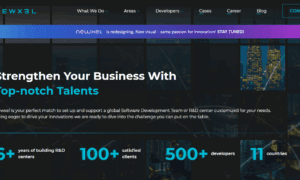25 AI-Driven Content Opportunities: Advice from Marketing Experts
Artificial intelligence is changing how marketers identify content opportunities, but knowing where to start can be overwhelming. This article brings together practical advice from marketing experts who are already using AI to uncover audience insights, spot content gaps, and make smarter strategic decisions. Learn how to use AI as a pattern detector and research assistant while maintaining the human judgment that turns data into action.
- Use AI as an Experimental Copilot
- Use AI to Challenge Your Judgment
- Treat AI as a Pattern Detector
- Uncover Insights and Amplify Strategic Decisions
- Teach AI to Listen for Patterns
- Let AI Be Your Pattern Recognition Engine
- Pair AI Insights With Human Judgment
- Start Using AI to Listen
- Automate Research to Focus on Strategy
- Use AI for Discovery Not Direction
- Analyze Competitor Comments for Hidden Insights
- Use AI as a Research Assistant
- Uncover Emotions Hidden Between the Lines
- Analyze What Works Then Expand Strategically
- Surface How Customers Actually Talk
- Quantify the Customer’s Most Urgent Fear
- Go Beyond Keywords to Intent Discovery
- Spot Patterns Then Apply Human Judgment
- Treat AI as an Insight Accelerator
- Experiment to Find the Right Fit
- Use AI to Spot Timing Gaps
- Provide Clear Direction for Fresh Ideas
- Research Active Searches and Trending Topics
- Explore Content Gaps Beyond Keywords
- Start With Data Not Assumptions
Use AI as an Experimental Copilot
Gen Z video format. One of the most surprising things I’ve seen happen with AI is how quickly it can reveal new formats for content that deliver significant returns, even for marketers who don’t have Hollywood budgets.
We worked with a local food brand whose usual social content was starting to suffer diminishing returns. With the help of AI-powered video analysis and trend detection tools, we found that meme-inspired video editing was crushing traditional ads significantly. The brand was able to produce a 45-second video that hit the meme while it was still trending. The result was over 22 million views and an increase in foot traffic the following week. The key thing was the speed with which the video got made, as well as the ability to test whether this format worked for them without lots of risk.
And my advice for content marketers looking to use AI is that they use it as an experimental co-pilot, but they should lead with humans.
Other than automating what they do now, content marketers can use AI to quickly test new ideas that they’d never have thought of. I suggest testing dozens of new content ideas a month with AI and doubling down on the ones that work.
They could start with a lightweight workflow that pulls trend data, uses AI to generate thematic variations of content (scripts, cuts, thumbnails) based on trends, and tracks which formats cause an increase in either baseline engagement or sales.

Use AI to Challenge Your Judgment
AI has been a steep learning curve for the Outsource Your Marketing content team. What we’ve discovered from experimenting with AI is that rather than using it to improve the speed with which we generate copy, it’s the potential depth of analysis it offers us that means we can spot emergent themes that were invisible to us before.
We had a client in financial services who wanted to dominate the topic of retirement planning for millennials. Instead of starting by looking at current search volume (which we knew was already lagging), we tried using AI to connect three different datasets:
1. Current SERPs – What’s ranking now – using high-level guides.
2. Forum Data – Scraped discussions from Reddit.
3. Legislative Data – Summaries of newly proposed (but not yet passed) government retirement savings bills.
Our prompt asked AI to act as a ‘Market Trend Analyst’ and find the ‘intersecting themes’ between these three data sources.
What the research told us was that high-income millennials were anxious about ‘clawbacks’ and ‘tax implications’ of new government legislation. What excited us was that AI had alerted us to new anxieties among millennials, derived from legislative rumors that were way ahead of search volume.
The OYM content team created a content cluster which we titled: ‘The 2026 Retirement Tax Trap – How Proposed Legislation Could Impact Your FIRE Journey.’ We were 6-8 months ahead of competitors, and it ranked #1 because ours was the only resource addressing this issue.
My advice to content marketers is based on this kind of experience with AI. I’ve grown used, over the years, to applying my authoritative judgment to content ideas. Now I have AI to give me a highly informed reality check. Instead of asking AI to write posts, therefore, I’m far more likely to ask: What am I missing in taking this approach to X?, or Give me 3 reasons why our competitor’s blog on X is better?
Using AI to challenge your own judgment is scary but it’s an excellent strategy. It saves you from committing budget to content that’s aimed at the wrong target audience or developed on false assumptions.

Treat AI as a Pattern Detector
AI helped me identify a new content opportunity by revealing intent patterns we were missing in our analytics. When analyzing topic clusters around speech and transcription technology, AI-driven keyword modeling showed that users weren’t just searching for “speech-to-text accuracy” but for comparisons like “real-time vs. batch transcription” and “AI models for noisy environments.”
Those insights shifted our content roadmap. We created a technical explainer comparing real-time processing pipelines and latency trade-offs, which ended up ranking in the top three results within a few weeks. It also attracted a new audience segment of developers researching API integrations, something we hadn’t directly targeted before.
My advice for content marketers is to treat AI not as a shortcut for writing but as a pattern detector. Let it surface the white space, the overlooked angles, questions, and use cases where real people are searching for clarity. Then use your creativity and expertise to turn those insights into content that educates and builds trust.
AI is incredible at finding signals in data, but it still needs human judgment to make those signals meaningful. The best results come when you combine machine precision with human storytelling.

Uncover Insights and Amplify Strategic Decisions
One of the most impactful instances where AI helped identify a new content opportunity was during a campaign analysis for a B2B SaaS client. Using AI-driven natural language processing and predictive analytics, we discovered that a large portion of organic search traffic was engaging with “how-to” queries related to AI automation compliance — a topic the client hadn’t directly addressed. Traditional analytics tools had overlooked it because the keywords were low-volume but high-intent.
By leveraging AI’s pattern recognition, we were able to detect emerging search intent before competitors did. We quickly developed a data-backed content series that positioned the client as a thought leader in automation ethics and compliance. Within three months, that content cluster became a top traffic driver, increasing qualified leads by 37% and earning backlinks from several reputable tech publications.
My advice for content marketers is simple but strategic: don’t use AI just to generate content — use it to uncover insights. The true value lies in how AI can identify micro-trends, sentiment shifts, and underserved audience segments. Pair those insights with human creativity and brand voice to craft content that’s both relevant and emotionally resonant.
In practice, integrate AI tools into your content lifecycle — from ideation and keyword clustering to performance analysis. Continuously train these systems with your internal data for more refined outputs. Ultimately, AI isn’t replacing marketers; it’s amplifying strategic decision-making, enabling you to move faster, personalize deeper, and engage smarter in an increasingly data-driven digital landscape.

Teach AI to Listen for Patterns
I once used a fine-tuned clustering model to find weirdly specific queries hidden three layers deep in our long-tail data. Think 5,000 variations of “X for Y in Z format” that we had never written a word about. It pulled in 370K visits over 8 months from a batch of 75 AI-generated articles. It worked because we paired high-volume silence with high-frequency search patterns. AI did not guess… it listened. That changed how I map content forever.
So, do not ask AI what to write. Teach it how to listen. Feed it your own raw keyword data, stripped down, unfiltered, 1,000+ at a time. Make it return patterns, gaps, and angles. Anything else is just busywork dressed up in automation. Keep your prompts mechanical and your goals messy. That mix will surface real opportunities, fast.

Let AI Be Your Pattern Recognition Engine
AI actually helped us identify a gap that our traditional analytics completely overlooked. We were immersed in observability content, but our tools highlighted something fascinating in search patterns and LinkedIn discussions—organizations around a few specific sectors were curious about observability for their AI workflows, not just their infrastructure. That one insight changed our entire content strategy and also the direction of our Live Observability webinar, which was to be held within the next few weeks.
We pivoted to focus on creating content around “observability in AI systems and infrastructure” around these specific sectors, a direction we hadn’t explicitly pursued before. The AI didn’t draft the strategy, but it did reveal the pattern faster than we could have done on our own. That’s the crucial difference.
Here’s some advice for marketing teams: let AI be your pattern-recognition engine, not your substitute. Leverage it to identify opportunities in search data, competitor content, and audience conversations. Then, it’s time to bring in and incorporate the AI-enabled, human-driven strategy. My team feeds AI tools with cleaned search volume data, industry reports, and our own engagement metrics to spot emerging trends and pinpoint fresh angles.
After that, it’s essential to verify everything through primary sources. When AI points out a trend, it is crucial to double-check for AI hallucinations or ingrained bias before validating it.
In our case, we confirmed the “observability in AI workflows and infrastructure alleged inclination or interest across certain sectors” angle by engaging directly with stakeholders and leaders from those sectors and researching and examining real industry reports. That kind of rigor is what differentiates strategic pivots from mere noise.
Ultimately, consider AI as a tool to be your research catalyst, one that helps your team speed up mundane tasks. It’s not just about speed for the sake of speed; it’s about allowing your team to break free from tedious tasks and concentrate on creative strategies. We went from recognizing trends to creating content pillars in just three weeks instead of three months. That’s where the magic is brewing!

Pair AI Insights With Human Judgment
At Solve, AI helped us uncover a valuable content opportunity when analyzing search intent data across our existing blogs. The tool flagged a pattern of queries around “sustainable web design,” which wasn’t a core topic we’d targeted.
We created a detailed guide aligned with those searches, and within weeks, it became one of our top-performing pages for organic traffic. The lesson? AI is brilliant for surfacing unseen trends—but it’s only powerful when paired with human judgment.
My advice is to use AI for insights, not output. Let it guide your creativity, not replace it, and you’ll spot opportunities competitors miss.

Start Using AI to Listen
The best content idea I ever got didn’t come from AI writing new posts; it came from AI reading our own comments. We had a 5,000-word “ultimate guide” that we thought was killing it because of its depth. But then, I fed over 500 comments and social chatter into AI and asked it to ignore the praise and find the top 3 things people were struggling with.
60% of the engagement wasn’t love; it was confusion over one sentence in paragraph four. Readers weren’t lost in the big picture; they were stuck at step one. We thought we’d written a masterpiece. Turns out they needed a simple, step-by-step fix.
So we took that one pain point and turned it into a detailed, multi-part series. It was an instant hit. My advice? Stop using AI to talk and start using it to listen. The real gold isn’t in competitors’ blogs. It’s in your hidden data. Thousands of blog comments, hundreds of support tickets, sales call notes. No human can read all that, but AI can.
Stop asking, “What should I write?” and start asking, “What are our customers stuck on that we’re ignoring?” That’s the content that actually wins.

Automate Research to Focus on Strategy
At Yarnit, we routinely use our agentic AI platform to research and identify content opportunities. By automating repetitive research tasks like keyword research, competitor analysis, and content gap analysis with our agents, we’re able to get an eagle-eye view of the market we’re looking to create content for. This allows us to focus on what really matters, like brainstorming impactful content ideas or tweaking the messaging in our content to hit the right notes with our target audience.
For content marketers who want to use AI, the first thing I’d tell them is to keep a dictionary of commonly-used words and use them as a negative prompt to smooth rewrites in the editing process. Also, double- and triple-check the facts and stats used in the content, as AI models still have some level of inaccuracy. The Wikipedia page on common signs of AI-generated content is worth a read as well, giving a more editorial angle to creating and editing AI-generated content.

Use AI for Discovery Not Direction
AI has become a creative partner in my content development process, particularly in uncovering insights that might escape human observation alone. A particularly effective example occurred when I used an AI topic clustering tool to analyze long-tail search patterns for a client’s wellness brand. The tool revealed an unexpected connection between “sleep recovery” and “metabolic health” – two areas we had been treating as separate content categories.
This insight led us to create an integrated content pillar that bridged these themes through articles, videos, and an interactive sleep-metabolism calculator. The results were impressive: our blog saw a 62% increase in organic traffic within four months, and we secured multiple featured snippets.
For content marketers looking to leverage AI, my advice is straightforward: use AI for discovery, not direction. Let these tools uncover your blind spots and reveal questions your audience is asking that you haven’t addressed. However, always keep the strategy and storytelling human-centered. AI excels at finding patterns in data, but only you can extract the meaningful narratives that resonate with your audience.

Analyze Competitor Comments for Hidden Insights
The most overlooked source of content opportunities sits in plain sight: competitor comments and audience feedback. AI has fundamentally changed how we extract actionable insights from this data.
Traditional competitor analysis focuses on what brands publish. The real intelligence lies in what their audiences say in response—the criticism, suggestions, and unmet needs expressed in comments across social media posts, campaigns, and product launches. These conversations reveal both content gaps and product positioning opportunities that competitors are missing.
The challenge has always been volume. Manually reviewing thousands of comments across multiple competitors isn’t scalable. This is where AI becomes essential. We use it to process large volumes of audience feedback, identifying recurring themes, sentiment patterns, and specific language that resonates with target consumers. The technology surfaces patterns that would take weeks to identify manually—common pain points, frequently requested features, or content formats that generate disproportionate engagement.
My advice to content marketers: If you’re uncertain where to begin with AI, start with competitive comment analysis. Use AI tools or targeted prompts to identify commonalities in what audiences are requesting or criticizing. Look for the suggestions that appear repeatedly across competitor content. These patterns often reveal content opportunities your competitors haven’t addressed—and that’s where you can differentiate.
The key is moving beyond surface-level observation to systematic pattern recognition. That’s where AI delivers the real measurable advantage.

Use AI as a Research Assistant
We use it to come up with content plans for us and our clients, so think blogs, YouTube videos, carousels, etc. So we did some prompt engineering so that we could take old podcast talks, blogs, Word docs, and knowledge bases for ourselves or about a client. We could do a one-hour question-round meeting and then feed it all to AI and have it then write a whole content brief for seven channels, so blogs, videos, carousels, infographics, etc., and like 50 pieces of content. This allows us to get a guide brief that then we overlay with human ideas and replace as necessary, but we move at speed. My advice for other marketers using AI is to use it as a really good research assistant around the human creative juices, but also you are only as good as the prompt you put in, as rubbish in, rubbish out!

Uncover Emotions Hidden Between the Lines
When we launched Aitherapy, I used AI to analyze thousands of Reddit conversations and Google search queries. It didn’t just show me that people cared about anxiety; it revealed that what they were really struggling with was overthinking. Phrases like “I can’t stop replaying things in my head” or “why do I always think the worst” kept surfacing. That emotional insight became our most successful content theme.
My advice is don’t use AI only to find keywords. Use it to uncover the emotions hiding between the lines. That’s where the real stories live.

Analyze What Works Then Expand Strategically
We recently analyzed performance data across our distribution network and noticed something interesting. Our AI spotted patterns in underperforming content that had strong engagement in specific niche communities. The data showed these pieces weren’t failing—they were simply reaching the wrong audiences. We pivoted our strategy and created targeted content for those micro-communities. The results were immediate. Engagement rates tripled, and we discovered an entirely new vertical for client campaigns that had been hiding in plain sight.
Content marketers should start small with AI. Don’t try to automate everything at once. Use AI to analyze what’s already working, then expand from there. Focus on pattern recognition first—let the technology show you trends you might miss manually. Test AI-generated insights against your instincts. Sometimes the data reveals counterintuitive opportunities that human analysis would dismiss. Keep your creative judgment central to the process. AI identifies possibilities, but you still need human expertise to execute them effectively. Start with one specific use case, measure results carefully, and scale only what delivers clear value.

Surface How Customers Actually Talk
I once used AI to analyze thousands of live chat transcripts and support tickets, and it uncovered something our keyword tools had completely missed (customers kept referring to “timesheet payroll” as if it were one thing). Technically, it’s two separate processes, but the insight helped us realize people were searching and thinking in that combined term.
We created a content piece that explained how integrated time and payroll systems work, using their exact language first before educating on the correct terminology. It started ranking for both variations, bringing in traffic that was ready to convert because it matched how they described their problem.
My advice to content marketers is simple: let AI surface how customers actually talk, not how marketers wish they did. The words they use (even when “wrong”) can reveal the perfect content gap to educate, disambiguate and convert.

Quantify the Customer’s Most Urgent Fear
My business doesn’t deal with “content opportunity” in the abstract sense. We deal with heavy-duty truck logistics, where our content is generated entirely by the urgent, high-stakes operational questions our customers ask. Our simple automation—our version of AI—helped us identify a new content opportunity by exposing a massive, recurring knowledge gap in the trade.
The situation arose when our automated support system—designed for initial triage—kept failing to provide a satisfactory answer for a very specific type of query: “How do I verify the authenticity of my OEM Cummins serial number?” The question was asked repeatedly, but no single resource online offered a direct, simple, authoritative answer. This exposed a massive content gap.
The new content opportunity we identified was the creation of the Official Digital Authentication Protocol. We immediately shifted resources to create detailed, step-by-step video guides and verifiable data tools that teach the customer precisely how to authenticate their high-value turbocharger assemblies against the manufacturer’s database. We did not use the AI to write the content; we used it to quantify the severity of the market’s biggest fear.
The advice I would give to content marketers looking to use automation is simple: Stop using AI to generate abstract ideas; use it to ruthlessly quantify the customer’s most urgent, non-negotiable operational fear. That fear is the single greatest content opportunity. The ultimate success is achieved by publishing content that eliminates the customer’s high-stakes risk, making your brand the only trustworthy source of truth.

Go Beyond Keywords to Intent Discovery
A notable instance was when we used an AI-driven content analysis tool to identify trending subtopics around “custom web design pricing” that were driving strong engagement but had low competition. By analyzing semantic gaps in competitor content and real-time search intent data, AI uncovered that users were searching for “hidden costs in web design projects,” a topic our clients had not covered.
We quickly produced an in-depth resource targeting this pain point, which not only ranked within a few weeks but also boosted organic leads by over 22%.
My advice for content marketers looking to leverage AI is to go beyond using it for keyword generation; use it for intent discovery. Let AI surface patterns in user behavior and competitor blind spots that humans might miss. Then, layer human judgment and storytelling on top to create content that resonates and converts.

Spot Patterns Then Apply Human Judgment
AI surfaced a content gap for one of our SaaS clients by analyzing search intent clusters around “rebate tracking.” We discovered users wanted “real-world examples,” not just definitions. Creating case study content around that topic drove a 42% lift in organic traffic within two months. My advice: don’t let AI decide topics alone—use it to spot patterns, then apply human judgment to craft angles that add genuine value.

Treat AI as an Insight Accelerator
AI proved especially valuable when I used it to analyze search intent gaps across a client’s service pages. For a home services brand operating in multiple cities, I used AI-driven topic clustering tools to process hundreds of Google Search Console queries and group them by intent and location. The AI identified recurring patterns—like “emergency repair near me” and “same-day [service] in [city]”—that weren’t covered in our existing content. These weren’t obvious keywords, but they reflected high-conversion, urgency-based intent.
We created a small batch of hyper-local landing pages and FAQs tailored to those AI-discovered clusters. Within two months, those pages attracted 24% more local organic clicks and started ranking in the map pack for several cities. What made this so effective was that the AI uncovered real behavior-based opportunities that manual keyword research might have missed.
My advice for content marketers using AI is to treat it as an insight accelerator, not an autopilot. Let AI surface trends, patterns, and gaps—but use human judgment to shape tone, local relevance, and authenticity. The winning combination is AI for discovery and human expertise for strategy and trust.

Experiment to Find the Right Fit
I’ve tried a lot of AI tools to find the right fit for uncovering new content ideas. Honestly, it really depends on your product, your SEO strategy, and how much time you have to test things out.
Lately, I’ve been using Amplitude’s new AEO tool, and it’s been great. It’s free, easy to use, and within a few minutes I had a handful of quick win opportunities that made sense for our audience.
If you’re a content marketer looking to use AI, my advice is to experiment. No single tool will be perfect, but the right one can help you spot new angles, move faster, and find ideas you might’ve missed.

Use AI to Spot Timing Gaps
AI tools helped us find trending keywords around “influencer gifting” before it got popular. We are a new website, and we are currently at page 2 already.
We spotted rising search volume and built PRpackage.com around it early. My advice: don’t just copy AI suggestions; use them to spot timing and intent gaps. Let AI surface patterns, but let your human insight decide which ideas actually fit your brand and audience.

Provide Clear Direction for Fresh Ideas
AI excels at generating fresh content ideas when provided with clear direction. For instance, you could prompt it with something like “You’re Martin Scorsese, come up with 10 new movie ideas that would be relevant to Gen Z+ in 2025.” With specific guidance, LLMs can produce truly innovative concepts.
However, it’s important to understand their limitations. LLMs aren’t effective at identifying emerging trends in real-time. They only recognize social media trends after they’ve gained significant traction and been acknowledged by humans. This is a fundamental constraint—trend identification through AI is always a lagging indicator. The trends must first develop and then get cataloged before an LLM can access that information.
Despite textual content, what AI has been getting a lot better at is audio and video content. With the latest Sora 2 and Veo 3.1 releases, one could not only produce short-form content but also 1 – 10 min long films. We’re still in the GPT 3.5 stage when it comes to video models. Audio models are closer to perfection. Given the rate at which things are moving, we could expect SOTA video models capable of generating 1 min+ long films with studio-grade accuracy. Luma Ray 3 is a great example of what video models could look like in the future (the first of its kind thinking, reasoning video model).

Research Active Searches and Trending Topics
We use more than just AI to identify content opportunities; it’s important to know what people are actively searching for using tools like answerthepublic.com. We then create articles and content around the topics of interest and relate those articles to our specific niche. A simple example is when the Las Vegas ‘Sphere’ first opened, many people were searching for it, and much viral content was being posted to TikTok and Instagram. We created a series of articles discussing the opening of the Sphere and related it to graphics, animation, and marketing to expand further on those niche topics.

Explore Content Gaps Beyond Keywords
The biggest AI-related opportunity we used was for a skincare brand that wanted to rank for some very competitive terms like “organic face serums.” Instead of targeting common keywords, we looked at how Google’s AI Overviews handle entity authority.
And it revealed an opportunity many competitors hadn’t noticed. It’s that Google’s AI systems are starting to reward pages that come with enhanced schema, data they generated themselves, and links to sources they trust. Most pages are focused purely on product features.
We used AI to help us create schema-laden content like ingredient interaction maps and dermatologist Q&As, and to generate data on ingredient effectiveness. A couple of months later, we were appearing in AI Overviews for several mid- and long-tail queries.
So my advice for content marketers is to stop thinking of AI as a keyword tool. They should use it to take their content marketing efforts to the next level. They should use it to explore content gaps by persona, intent, and position in the customer journey.

Start With Data Not Assumptions
AI has been a game-changer in identifying new content opportunities, and one example stands out clearly. While analyzing engagement data across multiple channels, we used an AI-powered analytics tool that went beyond surface-level metrics. It correlated search queries, social mentions, and performance data from existing content. The insight was striking: users were actively searching for quick, actionable answers on a specific product feature, yet our content strategy only offered long-form documentation. Engagement on those resources was low, and AI flagged this as a gap worth addressing. Acting on that insight, we created a series of short, visually engaging video tutorials optimized for social platforms and embedded within our help center. The result? A significant increase in engagement, higher completion rates, and improved conversions. This experience reinforced how AI can uncover patterns that humans might overlook, especially when dealing with large datasets and multiple touchpoints.
For content marketers looking to leverage AI, my advice is simple but powerful:
1. Start with data, not assumptions. AI thrives on patterns, so use it to analyze audience behavior, trending topics, and performance metrics. Let the insights guide your strategy rather than relying solely on intuition.
2. Leverage predictive analytics. AI can forecast emerging trends before they become mainstream, giving you a competitive edge in creating timely, relevant content.
3. Automate repetitive tasks. Keyword research, SEO optimization, and performance tracking can consume hours—AI can handle these efficiently, freeing you to focus on creativity.
4. Human-AI collaboration is key. AI provides insights, but creativity, empathy, and brand voice remain human strengths. Treat AI as a strategic partner, not a replacement.
5. Experiment and iterate. Use AI-driven A/B testing to refine headlines, formats, and distribution strategies quickly. The more you test, the smarter your content strategy becomes.
Ultimately, AI isn’t just about efficiency—it’s about unlocking opportunities you didn’t know existed. When used thoughtfully, it empowers marketers to create content that resonates deeply with audiences while staying ahead of the curve.
Related Articles
- AI-Driven Market Discovery: Success Stories and Expert Advice
- AI in Content Marketing: 18 Experts Share Results and Advice
- How AI Revolutionizes Real-Time Marketing: 18 Success Stories




































